Tetraselmis chuii Edible Microalga as a New Source of Neuroprotective Compounds Obtained Using Fast Biosolvent Extraction
Abstract
1. Introduction
2. Results and Discussion
2.1. In Vitro Neuroprotective Potential Optimization
2.1.1. Anticholinergic Activity In Vitro Assays
2.1.2. LOX In Vitro Assay
2.1.3. Antioxidant In Vitro Assays
2.2. PLE Optimization
2.3. Supercritical Fluid Extraction and Combined SFE-PLE Biorefinery Process
2.4. Chemical Characterization
2.4.1. GC-QTOF-MS Profiling Analysis
2.4.2. UHPLC-DAD-QTOF-MS/MS Profiling Analysis
2.5. Cytotoxicity Evaluation of T. chuii Extracts
3. Materials and Methods
3.1. Materials
3.2. Method
3.2.1. Optimization of the Pressurized Liquid Extraction (PLE) Procedure
3.2.2. Optimization of the Supercritical Fluid Extraction (SFE) Procedure
3.2.3. Chemical Characterization
Gas Chromatography–Mass Spectrometry Analysis (GC-QTOF-MS)
Liquid Chromatography–Mass Spectrometry Analysis (HPLC-DAD-MS/MS)
3.2.4. In Vitro Bioactivity Assays
Anti-Cholinergic Activity Assay
Antioxidant and Scavenging Radical Capacity Assays: ROS and RNS
Anti-Inflammatory Activity Assay
Total Phenolic Content (TPC)
3.2.5. Statistical Analysis
3.2.6. Cell Culture Experiments
HK-2 and THP-1 Cytotoxicity Assay
4. Conclusions
Supplementary Materials
Author Contributions
Funding
Data Availability Statement
Conflicts of Interest
References
- Musiek, E.S.; Holtzman, D.M. Three Dimensions of the Amyloid Hypothesis: Time, Space and “Wingmen”. Nat. Neurosci. 2015, 18, 800–806. [Google Scholar] [CrossRef] [PubMed]
- World Health Organisation. Global Action Plan on the Public Health Response to Dementia 2017–2025; World Health Organisation: Geneva, Switzerland, 2017.
- Hou, Y.; Dan, X.; Babbar, M.; Wei, Y.; Hasselbalch, S.G.; Croteau, D.L.; Bohr, V.A. Ageing as a Risk Factor for Neurodegenerative Disease. Nat. Rev. Neurol. 2019, 15, 565–581. [Google Scholar] [CrossRef] [PubMed]
- Chauhan, V.; Chauhan, A. Oxidative Stress in Alzheimer’s Disease. Pathophysiology 2006, 13, 195–208. [Google Scholar] [CrossRef] [PubMed]
- Masters, C.L.; Bateman, R.; Blennow, K.; Rowe, C.C.; Sperling, R.A.; Cummings, J.L. Alzheimer’s Disease. Nat. Rev. Dis. Primers 2015, 1, 15056. [Google Scholar] [CrossRef] [PubMed]
- Heneka, M.T.; O’Banion, M.K. Inflammatory Processes in Alzheimer’s Disease. J. Neuroimmunol. 2007, 184, 69–91. [Google Scholar] [CrossRef] [PubMed]
- Bauer, S.; Jin, W.; Zhang, F.; Linhardt, R.J. The Application of Seaweed Polysaccharides and Their Derived Products with Potential for the Treatment of Alzheimer’s Disease. Mar. Drugs 2021, 19, 89. [Google Scholar] [CrossRef] [PubMed]
- Cavdar, H.; Senturk, M.; Guney, M.; Durdagi, S.; Kayik, G.; Supuran, C.T.; Ekinci, D. Inhibition of Acetylcholinesterase and Butyrylcholinesterase with Uracil Derivatives: Kinetic and Computational Studies. J. Enzym. Inhib. Med. Chem. 2019, 34, 429–437. [Google Scholar] [CrossRef] [PubMed]
- Bueno, M.; Gallego, R.; Mendiola, J.A.; Ibáñez, E. Downstream Green Processes for Recovery of Bioactives from Algae. In Grand Challenges in Biology and Biotechnology; Springer Nature: Cham, Switzerland, 2019. [Google Scholar]
- Butcher, R.W.; Great Britain Ministry of Agriculture, Fisheries and Food. An Introductory Account of the Smaller Algae of British Coastal Waters. Part I: Introduction and Chlorophyceae; H.M.S.O.: London, UK, 1959.
- European Commission Commission Implementing Regulation (EU) 2017/2470. Off. J. Eur. Union 2017, 351, 72–201.
- FDA Gras Notice Inventory; US Food Drug Administration: Silver Spring, MD, USA, 2016; p. 26.
- Mantecón, L.; Moyano, R.; Cameán, A.M.; Jos, A. Safety Assessment of a Lyophilized Biomass of Tetraselmis Chuii (TetraSOD®) in a 90 Day Feeding Study. Food Chem. Toxicol. 2019, 133, 110810. [Google Scholar] [CrossRef]
- Banskota, A.H.; Sperker, S.; Stefanova, R.; McGinn, P.J.; O’Leary, S.J.B. Antioxidant Properties and Lipid Composition of Selected Microalgae. J. Appl. Phycol. 2019, 31, 309–318. [Google Scholar] [CrossRef]
- Banskota, A.H.; Gallant, P.; Stefanova, R.; Melanson, R.; Oleary, S.J.B. Monogalactosyldiacylglycerols, Potent Nitric Oxide Inhibitors from the Marine Microalga Tetraselmis Chui. Nat. Prod. Res. 2013, 27, 1084–1090. [Google Scholar] [CrossRef]
- Riccio, G.; Lauritano, C. Microalgae with Immunomodulatory Activities. Mar. Drugs 2020, 18, 2. [Google Scholar] [CrossRef] [PubMed]
- Raymundo, A.; Nunes, M.C.; Sousa, I. Microalgae Biomass as a Food Ingredient to Design Added Value Products. In Valorising Seaweed By-Products; Nova Science Publishers, Inc.: Hauppauge, NY, USA, 2019. [Google Scholar]
- Herrero, M.; Castro-Puyana, M.; Mendiola, J.A.; Ibañez, E. Compressed Fluids for the Extraction of Bioactive Compounds. TrAC—Trends Anal. Chem. 2013, 43, 67–83. [Google Scholar] [CrossRef]
- Bastante, C.C.; Tizón, S.R.; Cardoso, L.C.; Macías-Sánchez, M.D.; Serrano, C.M.; de la Ossa, E.J.M. Fractionation of Marine Microalgae Extract Using Supercritical CO2 with Progressive Addition of Co-Solvent for the Recovering of High-Valuable Compounds. Chem. Eng. Trans. 2022, 93, 259–264. [Google Scholar] [CrossRef]
- Grierson, S.; Strezov, V.; Bray, S.; Mummacari, R.; Danh, L.T.; Foster, N. Assessment of Bio-Oil Extraction from Tetraselmis Chui Microalgae Comparing Supercritical CO2, Solvent Extraction, and Thermal Processing. Energy Fuels 2012, 26, 248–255. [Google Scholar] [CrossRef]
- Kokkali, M.; Martí-Quijal, F.J.; Taroncher, M.; Ruiz, M.J.; Kousoulaki, K.; Barba, F.J. Improved Extraction Efficiency of Antioxidant Bioactive Compounds from Tetraselmis chuii and Phaedoactylum Tricornutum Using Pulsed Electric Fields. Molecules 2020, 25, 3921. [Google Scholar] [CrossRef]
- de Gonzalo, G.; Alcántara, A.R.; Domínguez de María, P. Cyclopentyl Methyl Ether (CPME): A Versatile Eco-Friendly Solvent for Applications in Biotechnology and Biorefineries. ChemSusChem 2019, 12, 2083–2097. [Google Scholar] [CrossRef] [PubMed]
- Wan Mahmood, W.M.A.; Theodoropoulos, C.; Gonzalez-Miquel, M. Enhanced Microalgal Lipid Extraction Using Bio-Based Solvents for Sustainable Biofuel Production. Green Chem. 2017, 19, 5723–5733. [Google Scholar] [CrossRef]
- Mussagy, C.U.; Santos-Ebinuma, V.C.; Kurnia, K.A.; Dias, A.C.R.V.; Carvalho, P.; Coutinho, J.A.P.; Pereira, J.F.B. Integrative Platform for the Selective Recovery of Intracellular Carotenoids and Lipids from: Rhodotorula Glutinis CCT-2186 Yeast Using Mixtures of Bio-Based Solvents. Green Chem. 2020, 22, 8478–8494. [Google Scholar] [CrossRef]
- Soquetta, M.B.; Terra, L.d.M.; Bastos, C.P. Green Technologies for the Extraction of Bioactive Compounds in Fruits and Vegetables. CYTA—J. Food 2018, 16, 400–412. [Google Scholar] [CrossRef]
- Alvarez-Rivera, G.; Bueno, M.; Ballesteros-Vivas, D.; Mendiola, J.A.; Ibañez, E. Pressurized Liquid Extraction. In Liquid-Phase Extraction; Elsevier: Amsterdam, The Netherlands, 2019. [Google Scholar]
- Gallego, R.; Valdés, A.; Suárez-Montenegro, Z.J.; Sánchez-Martínez, J.D.; Cifuentes, A.; Ibáñez, E.; Herrero, M. Anti-Inflammatory and Neuroprotective Evaluation of Diverse Microalgae Extracts Enriched in Carotenoids. Algal Res. 2022, 67, 102830. [Google Scholar] [CrossRef]
- Gallego, R.; Tardif, C.; Parreira, C.; Guerra, T.; Alves, M.J.; Ibáñez, E.; Herrero, M. Simultaneous Extraction and Purification of Fucoxanthin from Tisochrysis Lutea Microalgae Using Compressed Fluids. J. Sep. Sci. 2020, 43, 1967–1977. [Google Scholar] [CrossRef] [PubMed]
- Choi, J.S.; Haulader, S.; Karki, S.; Jung, H.J.; Kim, H.R.; Jung, H.A. Acetyl- and Butyryl-Cholinesterase Inhibitory Activities of the Edible Brown Alga Eisenia Bicyclis. Arch. Pharm. Res. 2015, 38, 1477–1487. [Google Scholar] [CrossRef] [PubMed]
- Pang, J.R.; How, S.W.; Wong, K.H.; Lim, S.H.; Phang, S.M.; Yow, Y.Y. Cholinesterase Inhibitory Activities of Neuroprotective Fraction Derived from Red Alga Gracilaria Manilaensis. Fish Aquat. Sci. 2022, 25, 49–63. [Google Scholar] [CrossRef]
- Olasehinde, T.A.; Olaniran, A.O.; Okoh, A.I. Cholinesterase Inhibitory Activity, Antioxidant Properties, and Phytochemical Composition of Chlorococcum Sp. Extracts. J. Food Biochem. 2021, 45, e13395. [Google Scholar] [CrossRef] [PubMed]
- Murugan, A.C.; Vallal, D.; Karim, M.R.; Govindan, N.; Yusoff, M.B.M.; Rahman, M.M. In Vitro Antiradical and Neuroprotective Activity of Polyphenolic Extract from Marine Algae Padina Australis H. J. Chem. Pharm. Res. 2015, 7, 355–362. [Google Scholar]
- Custódio, L.; Justo, T.; Silvestre, L.; Barradas, A.; Duarte, C.V.; Pereira, H.; Barreira, L.; Rauter, A.P.; Alberício, F.; Varela, J. Microalgae of Different Phyla Display Antioxidant, Metal Chelating and Acetylcholinesterase Inhibitory Activities. Food Chem. 2012, 131, 134–140. [Google Scholar] [CrossRef]
- Fagundes, M.B.; Alvarez-Rivera, G.; Mendiola, J.A.; Bueno, M.; Sánchez-Martínez, J.D.; Wagner, R.; Jacob-Lopes, E.; Zepka, L.Q.; Ibañez, E.; Cifuentes, A. Phytosterol-Rich Compressed Fluids Extracts from Phormidium Autumnale Cyanobacteria with Neuroprotective Potential. Algal Res. 2021, 55, 102264. [Google Scholar] [CrossRef]
- dos Santos Cardoso, A.; Santos, E.G.G.; da Silva Lima, A.; Temeyer, K.B.; Pérez de León, A.A.; Costa Junior, L.M.; dos Santos Soares, A.M. Terpenes on Rhipicephalus (Boophilus) Microplus: Acaricidal Activity and Acetylcholinesterase Inhibition. Vet. Parasitol. 2020, 280, 109090. [Google Scholar] [CrossRef] [PubMed]
- Dos Santos, T.C.; Gomes, T.M.; Pinto, B.A.S.; Camara, A.L.; De Andrade Paes, A.M. Naturally Occurring Acetylcholinesterase Inhibitors and Their Potential Use for Alzheimer’s Disease Therapy. Front. Pharmacol. 2018, 9, 1192. [Google Scholar] [CrossRef]
- Sánchez-Martínez, J.D.; Alvarez-Rivera, G.; Gallego, R.; Fagundes, M.B.; Valdés, A.; Mendiola, J.A.; Ibañez, E.; Cifuentes, A. Neuroprotective Potential of Terpenoid-Rich Extracts from Orange Juice by-Products Obtained by Pressurized Liquid Extraction. Food Chem. X 2022, 13, 100242. [Google Scholar] [CrossRef]
- Montenegro, Z.J.S.; Álvarez-Rivera, G.; Sánchez-Martínez, J.D.; Gallego, R.; Valdés, A.; Bueno, M.; Cifuentes, A.; Ibáñez, E. Neuroprotective Effect of Terpenoids Recovered from Olive Oil By-Products. Foods 2021, 10, 1507. [Google Scholar] [CrossRef] [PubMed]
- Sanchez-Martinez, J.D.; Bueno, M.; Alvarez-Rivera, G.; Tudela, J.; Ibanez, E.; Cifuentes, A. In Vitro Neuroprotective Potential of Terpenes from Industrial Orange Juice By-Products. Food Funct. 2021, 12, 302–314. [Google Scholar] [CrossRef] [PubMed]
- Feller, R.; Matos, Â.P.; Mazzutti, S.; Moecke, E.H.S.; Tres, M.V.; Derner, R.B.; Oliveira, J.V.; Junior, A.F. Polyunsaturated Ω-3 and Ω-6 Fatty Acids, Total Carotenoids and Antioxidant Activity of Three Marine Microalgae Extracts Obtained by Supercritical CO2 and Subcritical n-Butane. J. Supercrit. Fluids 2018, 133, 437–443. [Google Scholar] [CrossRef]
- Goiris, K.; Muylaert, K.; Fraeye, I.; Foubert, I.; De Brabanter, J.; De Cooman, L. Antioxidant Potential of Microalgae in Relation to Their Phenolic and Carotenoid Content. J. Appl. Phycol. 2012, 24, 1477–1486. [Google Scholar] [CrossRef]
- Shahidi, F.; Zhong, Y. Revisiting the Polar Paradox Theory: A Critical Overview. J. Agric. Food Chem. 2011, 59, 3499–3504. [Google Scholar] [CrossRef] [PubMed]
- Kamal, M.A.; Shakil, S.; Nawaz, M.S.; Yu, Q.; Tweedie, D.; Tan, Y.; Qu, X.; Greig, N.H. Inhibition of Butyrylcholinesterase with Fluorobenzylcymserine, An Experimental Alzheimer’s Drug Candidate: Validation of Enzoinformatics Results by Classical and Innovative Enzyme Kinetic Analyses. CNS Neurol. Disord. Drug Targets 2017, 16, 820–827. [Google Scholar] [CrossRef] [PubMed][Green Version]
- Suganthy, N.; Karutha Pandian, S.; Pandima Devi, K. Neuroprotective Effect of Seaweeds Inhabiting South Indian Coastal Area (Hare Island, Gulf of Mannar Marine Biosphere Reserve): Cholinesterase Inhibitory Effect of Hypnea Valentiae and Ulva Reticulata. Neurosci. Lett. 2010, 468, 216–219. [Google Scholar] [CrossRef] [PubMed]
- Pereira, H.; Custódio, L.; Rodrigues, M.J.; De Sousa, C.B.; Oliveira, M.; Barreira, L.; Neng, N.D.R.; Nogueira, J.M.F.; Alrokayan, S.A.; Mouffouk, F.; et al. Biological Activities and Chemical Composition of Methanolic Extracts of Selected Autochthonous Microalgae Strains from the Red Sea. Mar. Drugs 2015, 13, 3531–3549. [Google Scholar] [CrossRef]
- Burčul, F.; Blažević, I.; Radan, M.; Politeo, O. Terpenes, Phenylpropanoids, Sulfur and Other Essential Oil Constituents as Inhibitors of Cholinesterases. Curr. Med. Chem. 2018, 27, 4297–4343. [Google Scholar] [CrossRef]
- Syad, A.N.; Shunmugiah, K.P.; Kasi, P.D. Assessment of Anticholinesterase Activity of Gelidiella Acerosa: Implications for Its Therapeutic Potential against Alzheimer’s Disease. Evid.-Based Complement. Altern. Med. 2012, 2012, 497242. [Google Scholar] [CrossRef]
- Wojnowski, W.; Tobiszewski, M.; Pena-Pereira, F.; Psillakis, E. AGREEprep—Analytical Greenness Metric for Sample Preparation. TrAC—Trends Anal. Chem. 2022, 149, 116553. [Google Scholar] [CrossRef]
- Bimakr, M.; Rahman, R.A.; Taip, F.S.; Ganjloo, A.; Salleh, L.M.; Selamat, J.; Hamid, A.; Zaidul, I.S.M. Comparison of Different Extraction Methods for the Extraction of Major Bioactive Flavonoid Compounds from Spearmint (Mentha spicata L.) Leaves. Food Bioprod. Process. 2011, 89, 67–72. [Google Scholar] [CrossRef]
- Prado, I.M.; Prado, G.H.C.; Prado, J.M.; Meireles, M.A.A. Supercritical CO2 and Low-Pressure Solvent Extraction of Mango (Mangifera Indica) Leaves: Global Yield, Extraction Kinetics, Chemical Composition and Cost of Manufacturing. Food Bioprod. Process. 2013, 91, 656–664. [Google Scholar] [CrossRef]
- Sarpal, A.S.; Teixeira, C.M.L.L.; Costa, C.R.I.; Ferreira, L.C.; Silva, R.M.P.; Cunha, S.V.; Daroda, R.J. Evaluation of Low Cost Medium for the Production of Lipids for Biodiesel and Carotenoids from Microalgae Tetraselmis Aff Chuii. World J. Aquac. Res. Dev. 2019, 1, 1006. [Google Scholar]
- Moser, G.A.O.; Barrera-Alba, J.J.; Ortega, M.J.; Alves-de-Souza, C.; Bartual, A. Comparative Characterization of Three Tetraselmis Chui (Chlorophyta) Strains as Sources of Nutraceuticals. J. Appl. Phycol. 2022, 34, 821–835. [Google Scholar] [CrossRef]
- Avallone, R.; Vitale, G.; Bertolotti, M. Omega-3 Fatty Acids and Neurodegenerative Diseases: New Evidence in Clinical Trials. Int. J. Mol. Sci. 2019, 20, 4256. [Google Scholar] [CrossRef] [PubMed]
- Choi, B.W.; Lee, H.S.; Shin, H.C.; Lee, B.H. Multifunctional Activity of Polyphenolic Compounds Associated with a Potential for Alzheimer’s Disease Therapy from Ecklonia Cava. Phytother. Res. 2015, 29, 549–553. [Google Scholar] [CrossRef] [PubMed]
- Charlton, K.E.; Rabinowitz, T.L.; Geffen, L.N.; Dhansay, M.A. Lowered Plasma Vitamin C, but Not Vitamin E, Concentrations in Dementia Patients. J. Nutr. Health Aging 2004, 8, 99–107. [Google Scholar] [PubMed]
- Dong, S.; Huang, X.; Zhen, J.; Van Halm-Lutterodt, N.; Wang, J.J.; Zhou, C.; Yuan, L. Dietary Vitamin E Status Dictates Oxidative Stress Outcomes by Modulating Effects of Fish Oil Supplementation in Alzheimer Disease Model APPswe/PS1dE9 Mice. Mol. Neurobiol. 2018, 55, 9204–9219. [Google Scholar] [CrossRef]
- Norshazila, S.; Koy, C.N.; Rashidi, O.; Ho, L.H.; Azrina, I.; Nurul Zaizuliana, R.A.; Zarinah, Z. The Effect of Time, Temperature and Solid to Solvent Ratio on Pumpkin Carotenoids Extracted Using Food Grade Solvents. Sains. Malays. 2017, 46, 231–237. [Google Scholar] [CrossRef]
- Garrido, J.L.; Rodríguez, F.; Zapata, M. Occurrence of Loroxanthin, Loroxanthin Decenoate, and Loroxanthin Dodecenoate in Tetraselmis Species (Prasinophyceae, Chlorophyta). J. Phycol. 2009, 45, 366–374. [Google Scholar] [CrossRef] [PubMed]
- Brown, M.R.; Jeffrey, S.W. Biochemical Composition of Microalgae from the Green Algal Classes Chlorophyceae and Prasinophyceae. 1. Amino Acids, Sugars and Pigments. J. Exp. Mar. Biol. Ecol. 1992, 161, 91–113. [Google Scholar] [CrossRef]
- Gallego, R.; Valdés, A.; Sánchez-Martínez, J.D.; Suárez-Montenegro, Z.J.; Ibáñez, E.; Cifuentes, A.; Herrero, M. Study of the Potential Neuroprotective Effect of Dunaliella Salina Extract in SH-SY5Y Cell Model. Anal. Bioanal. Chem. 2022, 414, 5357–5371. [Google Scholar] [CrossRef] [PubMed]
- Vershinin, A. Biological Functions of Carotenoids-Diversity and Evolution. BioFactors 1999, 10, 99–104. [Google Scholar] [CrossRef] [PubMed]
- Katayama, S.; Ogawa, H.; Nakamura, S. Apricot Carotenoids Possess Potent Anti-Amyloidogenic Activity In Vitro. J. Agric. Food Chem. 2011, 59, 12691–12696. [Google Scholar] [CrossRef]
- Han, X.; Rozen, S.; Boyle, S.H.; Hellegers, C.; Cheng, H.; Burke, J.R.; Welsh-Bohmer, K.A.; Doraiswamy, P.M.; Kaddurah-Daouk, R. Metabolomics in Early Alzheimer’s Disease: Identification of Altered Plasma Sphingolipidome Using Shotgun Lipidomics. PLoS ONE 2011, 6, e21643. [Google Scholar] [CrossRef]
- Pahan, K. Lipid-Lowering Drugs. Cell. Mol. Life Sci. 2006, 63, 1165–1178. [Google Scholar] [CrossRef]
- Mielke, M.M.; Bandaru, V.V.R.; Han, D.; An, Y.; Resnick, S.M.; Ferrucci, L.; Haughey, N.J. Demographic and Clinical Variables Affecting Mid- to Late-Life Trajectories of Plasma Ceramide and Dihydroceramide Species. Aging Cell 2015, 14, 1014–1023. [Google Scholar] [CrossRef]
- Nolan, J.M.; Power, R.; Howard, A.N.; Bergin, P.; Roche, W.; Prado-Cabrero, A.; Pope, G.; Cooke, J.; Power, T.; Mulcahy, R. Supplementation With Carotenoids, Omega-3 Fatty Acids, and Vitamin E Has a Positive Effect on the Symptoms and Progression of Alzheimer’s Disease. J. Alzheimer’s Dis. 2022, 90, 233–249. [Google Scholar] [CrossRef]
- Gunness, P.; Aleksa, K.; Kosuge, K.; Ito, S.; Koren, G. Comparison of the Novel HK-2 Human Renal Proximal Tubular Cell Line with the Standard LLC-PK1 Cell Line in Studying Drug-Induced Nephrotoxicity. Can. J. Physiol. Pharmacol. 2010, 88, 448–455. [Google Scholar] [CrossRef]
- Morelli, L.; Giambartolomei, G.H.; Prat, M.I.; Castaño, E.M. Internalization and Resistance to Degradation of Alzheimer’s Aβ1-42 at Nanomolar Concentrations in THP-1 Human Monocytic Cell Line. Neurosci. Lett. 1999, 262, 5–8. [Google Scholar] [CrossRef] [PubMed]
- Fiehn, O. Metabolomics by Gas Chromatography-Mass Spectrometry: Combined Targeted and Untargeted Profiling. Curr. Protoc. Mol. Biol. 2016, 114, 30.4.1–30.4.32. [Google Scholar] [CrossRef] [PubMed]
- Gallego, R.; Arena, K.; Dugo, P.; Mondello, L.; Ibáñez, E.; Herrero, M. Application of Compressed Fluid–Based Extraction and Purification Procedures to Obtain Astaxanthin-Enriched Extracts from Haematococcus Pluvialis and Characterization by Comprehensive Two-Dimensional Liquid Chromatography Coupled to Mass Spectrometry. Anal. Bioanal. Chem. 2020, 412, 589–599. [Google Scholar] [CrossRef] [PubMed]
- Gallego, R.; Martínez, M.; Cifuentes, A.; Ibáñez, E.; Herrero, M. Development of a Green Downstream Process for the Valorization of Porphyridium Cruentum Biomass. Molecules 2019, 24, 1564. [Google Scholar] [CrossRef]
- Gallego, R.; Bueno, M.; Chourio, A.M.; Ibáñez, E.; Saldaña, M.D.A.; Herrero, M. Use of High and Ultra-High Pressure Based-Processes for the Effective Recovery of Bioactive Compounds from Nannochloropsis Oceanica Microalgae. J. Supercrit. Fluids 2021, 167, 105039. [Google Scholar] [CrossRef]
- Ellman, G.L.; Courtney, K.D.; Andres, V.; Featherstone, R.M. A New and Rapid Colorimetric Determination of Acetylcholinesterase Activity. Biochem. Pharmacol. 1961, 7, 88–95. [Google Scholar] [CrossRef] [PubMed]
- Ho, S.C.; Tang, Y.L.; Lin, S.M.; Liew, Y.F. Evaluation of Peroxynitrite-Scavenging Capacities of Several Commonly Used Fresh Spices. Food Chem. 2010, 119, 1102–1107. [Google Scholar] [CrossRef]
- Ou, B.; Hampsch-Woodill, M.; Prior, R.L. Development and Validation of an Improved Oxygen Radical Absorbance Capacity Assay Using Fluorescein as the Fluorescent Probe. J. Agric. Food Chem. 2001, 49, 4619–4626. [Google Scholar] [CrossRef]
- Whent, M.; Ping, T.; Kenworthy, W.; Yu, L. High-Throughput Assay for Detection of Soybean Lipoxygenase-1. J. Agric. Food Chem. 2010, 58, 12602–12607. [Google Scholar] [CrossRef]
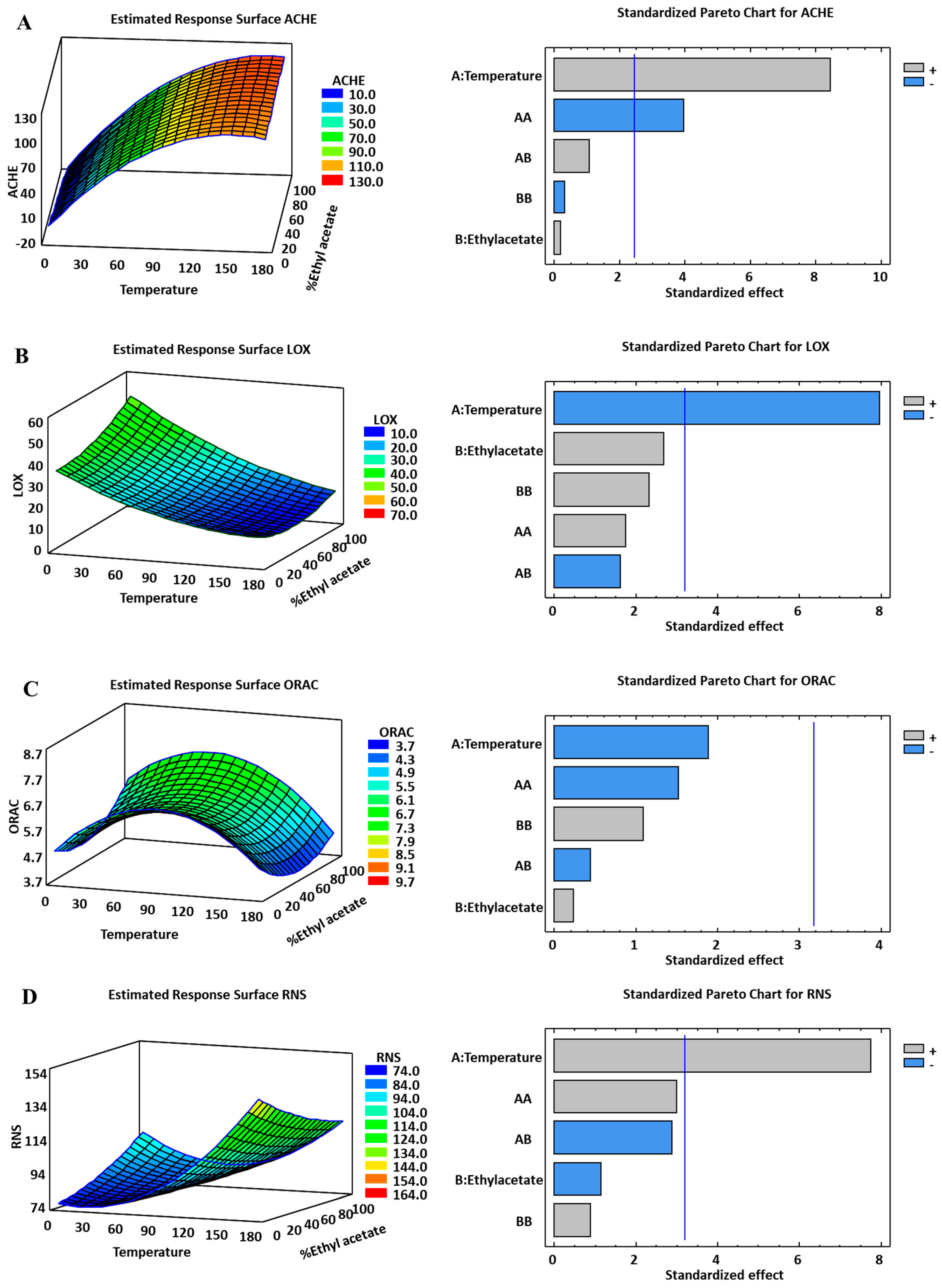
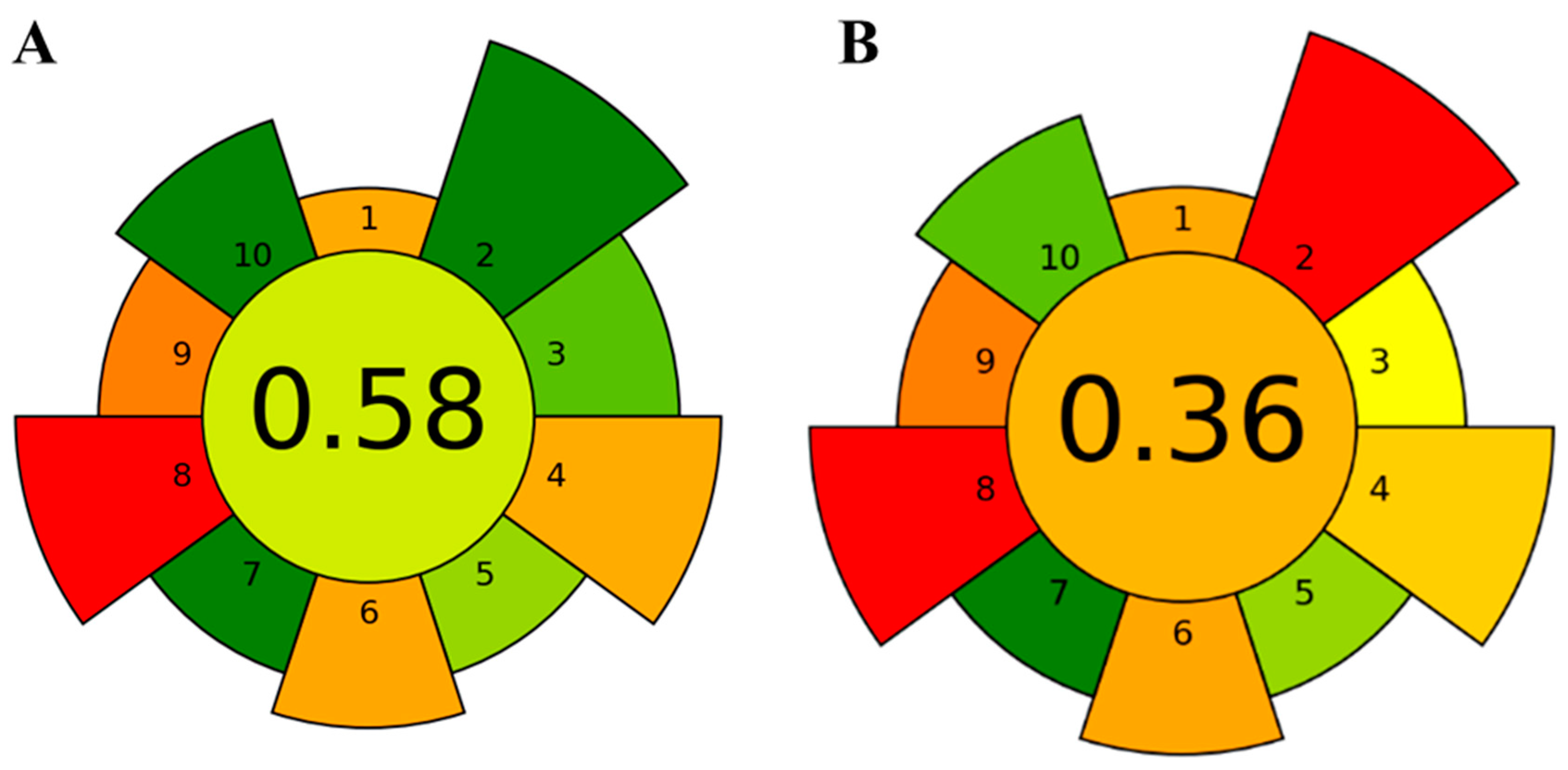
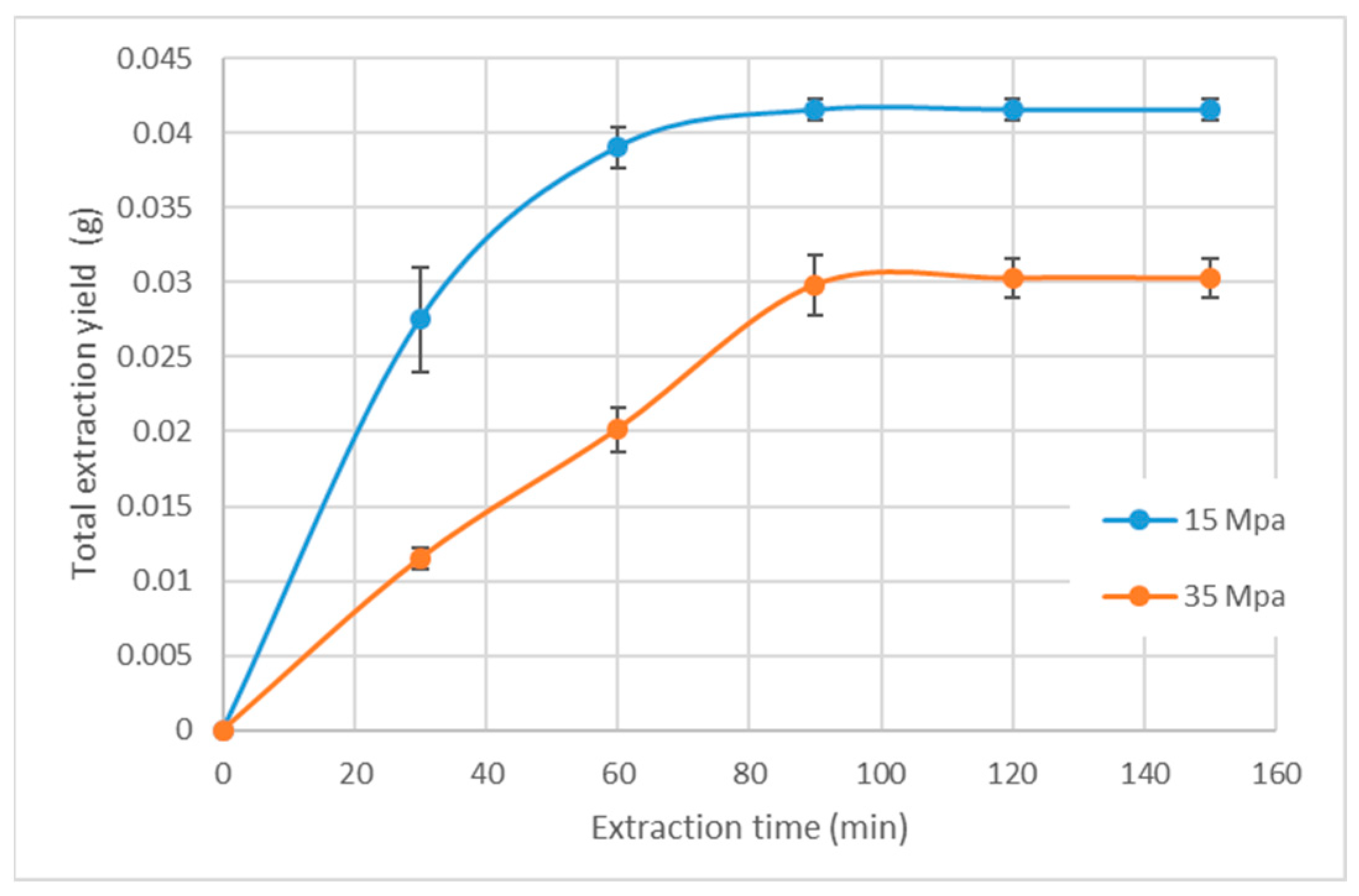
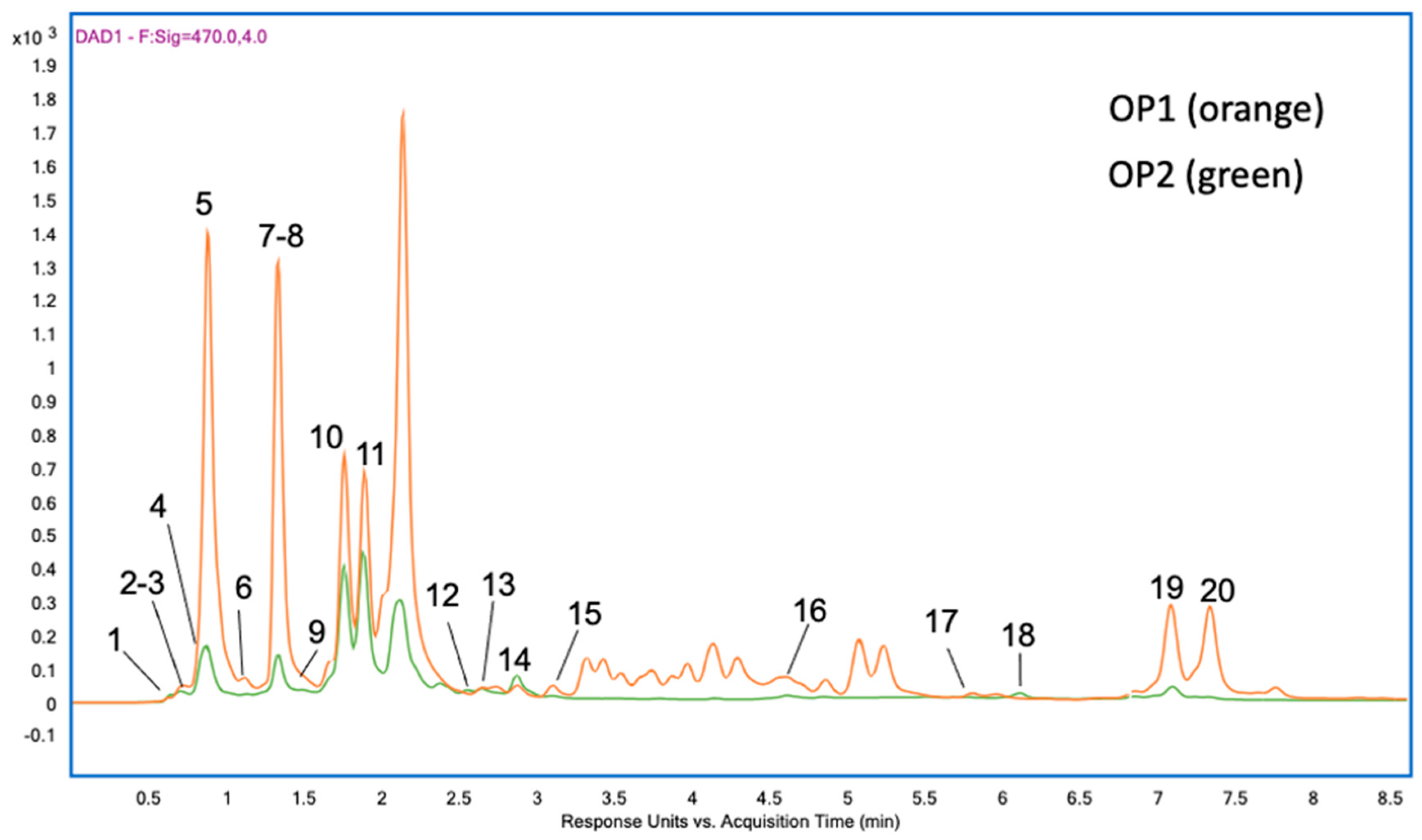
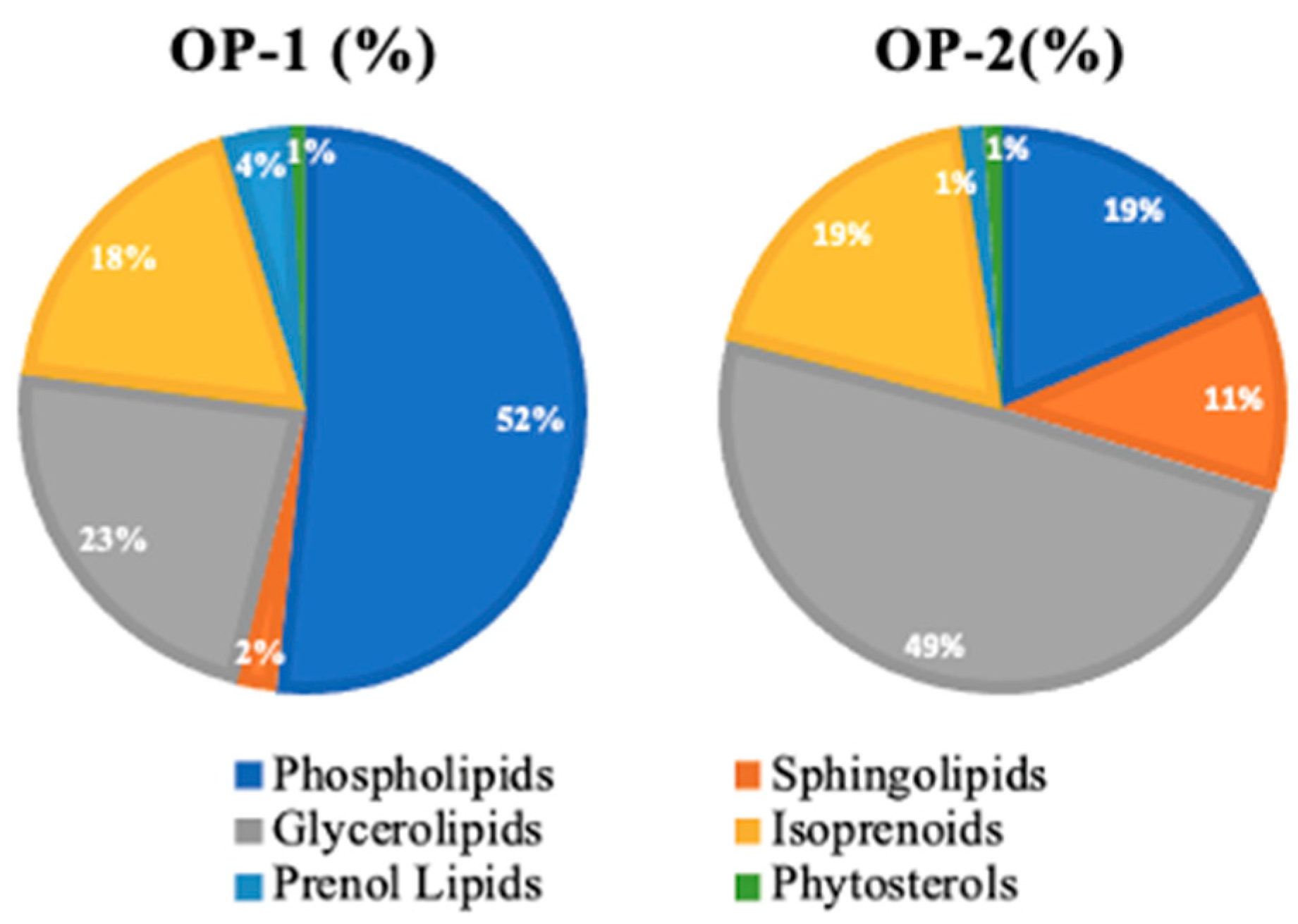
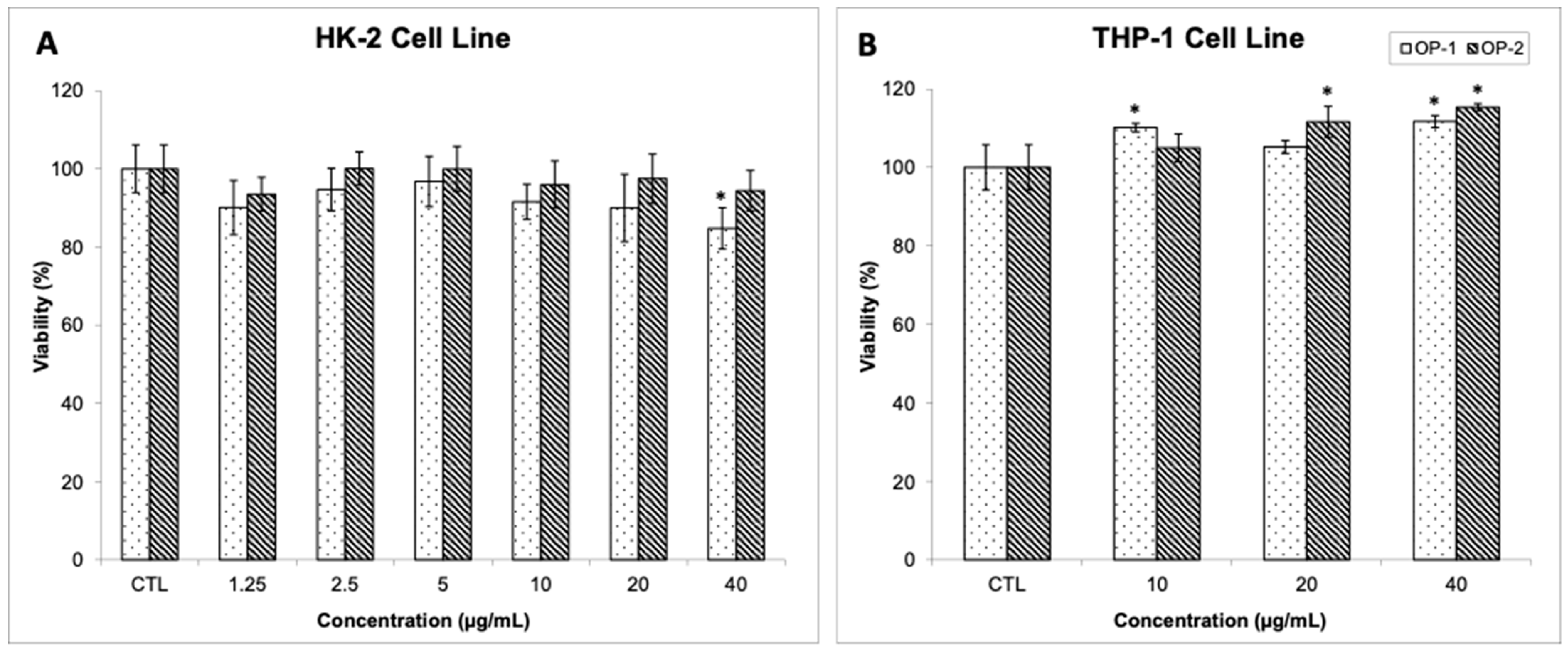
| Extraction Conditions | Response Variables | |||||||
|---|---|---|---|---|---|---|---|---|
| Run | Temperature (°C) | Ethyl Acetate in CPME (%) | TPC | ORAC | RNS | AChE | LOX | Yield (%) |
| (mg GAE/g §) | (IC50 µg·mL−1) | (IC50 µg·mL−1) | (IC50 µg·mL−1) | (IC50 µg·mL−1) | ||||
| 1 | 40 (−1) | 0 (−1) | 593.94 ± 2.6 d | 5.35 ± 0.1 e | 79.22 ± 14.5 de | 41.11 ± 4.5 c | 27.04 ± 2.6 c | 3.58 ± 0.2 ef |
| 2 | 40 (−1) | 50 (0) | 593.94 ± 2.0 d | 6.77 ± 0.2 bc | 77.04 ± 10.5 e | 52.95 ± 3.4 c | 29.53 ± 1.7 c | 3.81 ± 0.2 e |
| 3 | 40 (−1) | 100 (1) | 628.12 ± 3.7 b | 6.79 ± 0.1 bc | 86.97 ± 12.3 de | 41.21 ± 2.2 c | 38.86 ± 4.1 b | 3.06 ± 0.2 f |
| 4 | 110 (0) | 0 (−1) | 536.14 ± 1.2 h | 7.91 ± 0.3 a | 91.79± 10.8 de | 111.84 ± 1.0 ab | 17.91 ± 1.0 d | 5.77 ± 0.4 c |
| 5 * | 110 (0) | 50 (0) | 557.01 ± 1.2 f | 4.99 ± 0.3 ef | 94.18 ± 8.3 de | 98.32 ± 10.0 b | 16.99 ± 1.4 d | 4.79 ± 0.2 d |
| 6 * | 110 (0) | 50 (0) | 562.09 ± 2.1 f | 6.18 ± 0.5 cd | 88.29 ± 4.7 de | 105.37 ± 9.2 ab | 13.43 ± 0.4 de | 5.94 ± 0.4 c |
| 7 * | 110 (0) | 50 (0) | 602.51 ± 2.5 c | 4.24 ± 0.3 fg | 76.52 ± 8.9 e | 101.34 ± 9.7 ab | 18.06 ± 0.8 d | 5.87 ± 0.3 c |
| 8 * | 110 (0) | 50 (0) | 550.32 ± 1.2 g | 7.12 ± 0.4 ab | 89.72 ± 11.5 de | 117.47 ± 14.1 ab | 11.44 ± 1.2e | 5.91 ± 0.3 c |
| 9 | 110 (0) | 100 (1) | 579.49 ± 1.2 e | 6.90 ± 0.2 bc | 98.71 ± 12.6 de | 95.06 ± 10.2 b | 24.35 ± 2.3 c | 5.89 ± 0.3 c |
| 10 | 180 (1) | 0 (−1) | 584.31 ± 2.6 e | 4.38 ± 0.1 fg | 144.72 ± 8.5 b | 126.85 ± 10.3 a | 11.44± 1.2 e | 11.43 ± 0.3 a |
| 11 | 180 (1) | 50 (0) | 644.52 ± 2.8 a | 3.97 ± 0.5 gh | 132.82 ± 11.2 bc | 108.74 ± 16.7 ab | 10.64 ± 0.5 e | 11.37 ± 0.2 a |
| 12 | 180 (1) | 100 (1) | 622.57 ± 2.5 b | 4.70 ± 0.2 efg | 108.97 ± 9.7 cd | 128.30 ± 9.6 a | 13.31 ± 0.7 de | 7.84 ± 0.7 b |
| Galantamine | 1.40 ± 0.2 d | |||||||
| Quercetin | 119.20 ± 1.5 a | |||||||
| Ascorbic Acid | 3.26 ± 0.20 h | 990.11 ± 12.6 a | ||||||
| Extraction Conditions | Response Variables | ||||||||
|---|---|---|---|---|---|---|---|---|---|
| Temp. (°C) | Ethyl Acetate in CPME (%) | ORAC * | RNS * | AchE * | LOX * | Yield (%) | BuChE * | ||
| (IC50 µg·mL−1) | (IC50 µg·mL−1) | (IC50 µg·mL−1) | (IC50 µg·mL−1) | (IC50 µg·mL−1) | |||||
| Optimum 1 | Predicted | 40 | 35 | - | 76.5 | 47.5 | - | - | - |
| Experimental | 40 | 35 | 9.7 ± 0.9 | 89.2 ± 8.6 | 44.3 ± 3.4 | 22.6 ± 3.0 | 3.9 ± 0.5 | 48.8 ± 7.0 | |
| % RSD | 9.5 | 9.7 | 7.8 | 13.1 | 12.4 | 14.3 | |||
| Optimum 2 | Predicted | 180 | 55 | 3.7 | - | - | 9 | 10.4 | - |
| Experimental | 180 | 55 | 3.3 ± 0.4 | 120.5 ± 12.9 | 82.9 ± 1.9 | 11.6 ± 1.4 | 11.48 ± 1.37 | 65.7 ± 2.4 | |
| % RSD | 11.6 | 10.7 | 2.2 | 11.9 | 11.9 | 3.6 | |||
| Extraction Conditions | Response Variables | |||||
|---|---|---|---|---|---|---|
| Density (kg/m3) | Temp. (°C) | Pressure (MPa) | ORAC (IC50 µg·mL−1) | AchE (IC50 µg·mL−1) | LOX (IC50 µg·mL−1) | Yield (%) |
| 780.3 | 40 | 15 | 9.16 ± 1.08 | 121.26 ± 2.96 | 45.61 ± 4.64 | 4.14 ± 0.21 |
| 934.9 | 40 | 35 | 21.66 ± 3.64 | 144.82 ± 5.97 | 39.56 ± 2.24 | 2.99 ± 0.09 |
| Peak No | Ret. Time (min) | Ret. Index | Family | Tentative Identification | Match Factor | Formula | Main Fragments (m/z) | OP-1 (%) | OP-2 (%) |
|---|---|---|---|---|---|---|---|---|---|
| 1 | 11.369 | 1453 | FA (C10:0) | Decanoic acid | 75 | C10H20O2 | 229.1609, 117.0358 | 0.2 | 0.2 |
| 2 | 13.696 | 1651 | FA (C12:0) | Dodecanoic acid | 82 | C12H24O2 | 257.1924, 117.0358 | 0.2 | 0.2 |
| 3 | 15.704 | 1837 | Terpene | Neophytadiene | 89 | C20H38 | 123.1175, 95.0864 | 10.02 | 8.1 |
| 4 | 15.815 | 1845 | FA (C14:0) | Tetradecanoic acid | 89 | C14H28O2 | 285.2250, 117.0358 | 1.2 | 1.2 |
| 5 | 16.442 | 1944 | FA (C15:0) | Pentadecanoic acid | 81 | C15H30O2 | 299.2395, 117.0361 | 0.2 | 0.2 |
| 6 | 16.844 | - | PUFA (C16:4n-3) | Methyl 4,7,10,13-hexadecatetraenoate | 80 | C17H26O2 | 117.0361, 91.0532 | 0.2 | 0.1 |
| 7 | 17.237 | 1979 | FA (C16:0) | Hexadecanoic acid, ethyl ester | 75 | C18H36O2 | 241.2153, 157.1203 | 0.1 | 0.1 |
| 8 | 17.511 | 1995 | MUFA (C16:1n-7) | (E)-9-Hexadecenoic acid | 94 | C16H30O2 | 311.2407, 129.0372 | 2.1 | 2.5 |
| 9 | 17.565 | 1995 | MUFA (C16:1n-7) | (Z)-9-Hexadecenoic acid | 96 | C16H30O2 | 311.2407, 129.0372 | 1.2 | 1.2 |
| 10 | 17.753 | 2042 | FA (C16:0) | Hexadecanoic acid | 95 | C16H32O2 | 313.2604, 117.0401 | 12.9 | 15.8 |
| 11 | 18.866 | 2158 | MUFA (C18:1n-9) | (Z)-9-Octadecenoic acid, ethyl ester | 87 | C20H38O2 | 264.2439, 222.2313 | 3.4 | 3.1 |
| 12 | 18.964 | 2180 | Terpene | Phytol | 96 | C20H40O | 143.0900, 123.1166 | 2.9 | 3.6 |
| 16 | 19.272 | 2201 | PUFA (C18:2n-6) | (Z,Z)-9,12-Octadecadienoic acid | 96 | C18H32O2 | 337.2576, 129.0371 | 2.8 | 2.5 |
| 17 | 19.322 | 2208 | MUFA (C18:1n-9) | (Z)-Octadec-9-enoic acid | 95 | C18H34O2 | 339.2763, 129.0391 | 17.1 | 16.8 |
| 18 | 19.339 | 2218 | PUFA (C18:3n-3) | (Z,Z,Z)-9,12,15-Octadecatrienoic acid | 93 | C18H30O2 | 335.2424, 129.0388 | 12.1 | 11.0 |
| 19 | 19.533 | 2239 | FA (C18:0) | Octadecanoic acid | 86 | C18H36O2 | 341.2875, 129.0388 | 0.7 | 0.9 |
| 20 | 20.003 | 2326 | MUFA (C19:1n-9) | (E)-10-Nonadecenoic acid | 63 | C19H36O2 | 353.3232, 117.0702 | 0.7 | 0.4 |
| 21 | 20.143 | 2326 | MUFA (C19:1n-9) | (Z)-10-Nonadecenoic acid | 78 | C19H36O2 | 353.3232, 117.0702 | 0.1 | 0.1 |
| 23 | 20.623 | 2359 | PUFA (C20:4n-6) | (Z,Z,Z,Z)-5,8,11,14-Eicosatetraenoic acid | 94 | C20H32O2 | 117.0470, 91.0535 | 0.6 | 0.6 |
| 24 | 20.687 | 2380 | PUFA (C20:5n-3) | (Z,Z,Z,Z,Z)-5,8,11,14,17-Eicosapentaenoic acid | 97 | C20H30O2 | 117.0584, 105.0704 | 11.4 | 11.9 |
| 26 | 20.978 | 2426 | MUFA (C20:1n-9) | (Z)-11-Eicosenoic acid | 93 | C20H38O2 | 367.3044, 117.0370 | 2.8 | 3.4 |
| 28 | 24.116 | 2830 | FA (C24:0) | Lignoceric acid | 72 | C24H48O2 | 425.3819, 117.0379 | 0.1 | 0.2 |
| 29 | 25.444 | - | Phytosterol | Campesterol acetate | 77 | C31H52O2 | 382.3591, 147.1117 | 0.2 | 0.2 |
| 30 | 26.091 | 3132 | Tocopherol | α-Tocopherol acetate | 67 | C35H60O7 | 430.3814, 165.0901 | 0.6 | 0.3 |
| 31 | 26.269 | 3226 | Tocopherol | α-Tocopherol | 79 | C29H50O2 | 502.4224, 237.1305 | 1.1 | 1.0 |
| 32 | 26.386 | 3135 | Phytosterol | Cholesterol | 72 | C27H46O | 368.3416, 329.3195 | 0.1 | 0.1 |
| 33 | 27.020 | - | Phytosterol | Isofucosterol | 80 | C29H48O | 386.3010, 296.2500 | 2.3 | 2.2 |
| 34 | 27.063 | 3250 | Phytosterol | Campesterol | 94 | C28H48O | 472.4129, 382.3630 | 12.5 | 11.8 |
| No | Ret Time (min) | Identification | Molecular Formula | Monoisotopic Mass | Theoretical [M + H]+ m/z | Experimental [M + H]+ m/z | Error (ppm) | λmax (nm) | MS/MS Product Ions |
|---|---|---|---|---|---|---|---|---|---|
| 1 | 0.85 | Fucoxanthinol | C40H56O5 | 616.4128 | 617.4201 | 617.4191 | 1.6 | 400s, 420, 447 | 615.4/599.4106/221.1535 |
| 2 | 0.91 | Diatoxanthin | C40H54O2 | 566.4124 | 567.4197 | 567.4208 | −2.0 | 400s, 418, 443 | 549.4085/427.2991/349.2511 |
| 3 | 0.92 | Neoxanthin | C40H56O4 | 604.178 | 601.4251 | 601.4266 | −2.5 | 420s, 438, 464 | 583.4123/565.4004/491.3454 |
| 4 | 0.94 | Diadinoxanthin | C40H54O3 | 582.4073 | 583.4146 | 583.4103 | 7.3 | 420s, 440, 465 | 565.4029/547.3991/491.3521 |
| 5 | 1.06 | Violaxanthin | C40H56O4 | 600.4178 | 601.4251 | 601.4258 | −1.2 | 400, 420, 448 | 583.4087/565.3971/491.3425 |
| 6 | 1.19 | Prasinoxanthin | C40H56O4 | 600.4178 | 601.4251 | 601.4235 | 2.6 | 380, 400, 425 | 583.4377/565.4224/335.2581 |
| 7 | 1.40 | Zeaxanthin/lutein | C40H56O2 | 568.4280 | 569.4353 | 569.4337 | 2.8 | 420s, 445, 475 | 551.4208/489.3705/431.3281 |
| 8 | 1.40 | Crocoxanthin | C40H54O | 550.4175 | 551.4213 | 551.4229 | −2.9 | 420s, 445, 475 | 533.4096/495.3582/429.3073 |
| 9 | 1.45 | Antheraxanthin | C40H56O3 | 584.4229 | 585.4432 | 585.445 | −3.1 | 426, 448, 474 | 567.4369/493.4007/384.3338 |
| 10 | 1.80 | Echinenone I | C40H54O2 | 566.4124 | 567.4197 | 567.4158 | 6.8 | 455 | 549.4025/475.3372/429.3101 |
| 11 | 2.19 | Echinenone II | C40H54O2 | 566.4124 | 567.4197 | 567.4141 | 9.8 | 460 | 549.4025/429.3101/411.3075 |
| 12 | 2.60 | Divinylchlorophyll a | C55H70MgN405 | 890.5197 | 891.5270 | 891.5319 | −5.5 | 422 | 613.2292/581.1968/553.2077 |
| 13 | 2.62 | 7-Hydroxychlorophyll a | C55H72MgN4O6 | 908.5302 | 909.5386 | 909.5311 | 8.2 | 422 | 631.2385/558.2091 |
| 14 | 2.64 | Chlorophyll a | C55H72MgN4O5 | 892.5353 | 893.5426 | 893.5299 | 14.2 | 422 | 603.4616/429.3718 |
| 15 | 3.09 | Chlorophyll b | C55H70MgN4O6 | 906.5145 | 907.5218 | 907.5199 | 2.1 | 420 | 629.2225/889.6502/601.2252 |
| 16 | 4.66 | Pyropheophytin b | C53H70N4O4 | 826.5397 | 827.5481 | 827.5437 | 5.3 | 400 | 549.2468/503.2394 |
| 17 | 5.72 | Pheophytin a | C55H74N4O5 | 870.5659 | 871.5743 | 871.5723 | 2.3 | 410 | 593.2761/533.2581 |
| 19 | 7.00 | α-Carotene | C40H56 | 536.4382 | 537.4455 | 537.4460 | −1.0 | 418, 447, 474 | 457.3877/441.3535/414.329 |
| 20 | 7.25 | β-Carotene | C40H56 | 536.4382 | 537.4455 | 537.4454 | 0.1 | 430s, 452,478 | 457.3826/413.3202 |
Disclaimer/Publisher’s Note: The statements, opinions and data contained in all publications are solely those of the individual author(s) and contributor(s) and not of MDPI and/or the editor(s). MDPI and/or the editor(s) disclaim responsibility for any injury to people or property resulting from any ideas, methods, instructions or products referred to in the content. |
© 2024 by the authors. Licensee MDPI, Basel, Switzerland. This article is an open access article distributed under the terms and conditions of the Creative Commons Attribution (CC BY) license (https://creativecommons.org/licenses/by/4.0/).
Share and Cite
Cokdinleyen, M.; Alvarez-Rivera, G.; Tejera, J.L.G.; Mendiola, J.A.; Valdés, A.; Kara, H.; Ibáñez, E.; Cifuentes, A. Tetraselmis chuii Edible Microalga as a New Source of Neuroprotective Compounds Obtained Using Fast Biosolvent Extraction. Int. J. Mol. Sci. 2024, 25, 3897. https://doi.org/10.3390/ijms25073897
Cokdinleyen M, Alvarez-Rivera G, Tejera JLG, Mendiola JA, Valdés A, Kara H, Ibáñez E, Cifuentes A. Tetraselmis chuii Edible Microalga as a New Source of Neuroprotective Compounds Obtained Using Fast Biosolvent Extraction. International Journal of Molecular Sciences. 2024; 25(7):3897. https://doi.org/10.3390/ijms25073897
Chicago/Turabian StyleCokdinleyen, Melis, Gerardo Alvarez-Rivera, Jose Luis González Tejera, José A. Mendiola, Alberto Valdés, Huseyin Kara, Elena Ibáñez, and Alejandro Cifuentes. 2024. "Tetraselmis chuii Edible Microalga as a New Source of Neuroprotective Compounds Obtained Using Fast Biosolvent Extraction" International Journal of Molecular Sciences 25, no. 7: 3897. https://doi.org/10.3390/ijms25073897
APA StyleCokdinleyen, M., Alvarez-Rivera, G., Tejera, J. L. G., Mendiola, J. A., Valdés, A., Kara, H., Ibáñez, E., & Cifuentes, A. (2024). Tetraselmis chuii Edible Microalga as a New Source of Neuroprotective Compounds Obtained Using Fast Biosolvent Extraction. International Journal of Molecular Sciences, 25(7), 3897. https://doi.org/10.3390/ijms25073897










